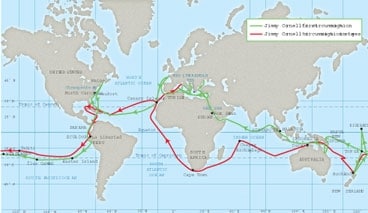
Cornell368
Flights
As your flights home will always originate in the country where the boat will be left, it is advisable to buy tickets via a local agent rather than online. If buying online some airlines (British Airways, Virgin) will only accept payment by credit card if the account is registered in the country where the flight originates. An important advice is not be tempted to buy the cheapest tickets as they are usually unchangeable and as invariably plans change, it is more prudent to either buy a flexible ticket or to ensure that the airline in question will allow changes to be made on payment of a specified penalty. Equally important is to have comprehensive travel insurance that covers not only cancellations but also personal health. Obtaining this type of policy may be difficult for those who are already underway, so it advisable to start buying such insurance before the planned voyage in the hope that you can renew it more easily later on.
Crew or family planning to join the boat on a one-way ticket may not be allowed to board at departure as airlines are responsible for the repatriation of passengers who may be denied entry at the airport of arrival. In many countries passengers are only allowed entry if they have a return ticket or a valid onward ticket. As in many cases crew may arrive with what is called in the airline business an open-jaw ticket (say Los Angeles to Tahiti returning from Auckland to Los Angeles), immigration may insist on arrival that they must buy a ticket for the missing section. If this cannot be avoided the best solution is to buy such a ticked from a better airline and make sure that it is fully refundable so they can be redeemed later if not used.
Costs
As a rough estimate I guess that, over the five years of the voyage, my own costs averaged about $20,000 per year. This included marinas and laying up fees, insurance, maintenance, repairs, spares and servicing, fuel and provisioning, car rental, the occasional hotel, eating out, charts, cruising guides, communications, but not flights or longer trips inland.
The annual cost may seem high but is only about twice what it would have cost me in docking and insurance fees alone if the boat had spent all that time sitting in a marina in the South of France. Whichever way I look at it I feel that not only was it money well spent, but that it was actually less than I had expected. An unexpected outcome is that on completion of her voyage Aventura is in a better state than when she had left, having been regularly serviced professionally. This, I feel, is the right place to point out that one of the greatest pleasures that I get nowadays is the ability to have jobs done when needed, and employ the best professionals available. Not only has this made my voyaging much safer but also so much less stressful.
Even those thousands of miles that I spent in airplanes commuting between the boat and home were not as expensive as I had expected, and I did not even look for the cheapest deals. As we get older, Gwenda and I prefer not to fly in coach/economy class on longer flights. Two sailing friends, both in their early sixties, had developed DVT (deep vein thrombosis) during long flights from their boats to their homes, when they spent many hours squeezed into a tight economy seat. Both had to be hospitalised and could have lost their lives. Air New Zealand, which I regard as the best airline in the world, and have used on several trips to and from the South Pacific, had some special offers in business class. Unfortunately most airlines charge such outrageous fares in this class that it is easy to resist temptation. Some European airlines now have a very convenient premium economy or economy plus class, which we often use as it has wide, comfortable seats and much more leg room, similar to the old business class before the current, totally reclining seats that form a bed were introduced. Fares in premium economy are usually about three times more than economy, while for business class some airlines charge as much as ten times the cheapest return fare.







